Introduction and Drive Specifications
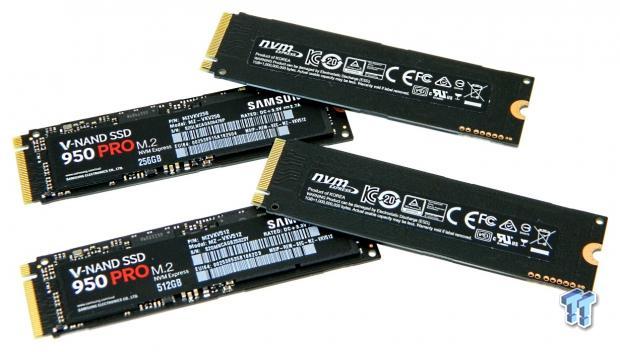
TweakTown is the leading purveyor of RAID 0 reviews, but we haven't done one for a long time. Why? Simply because a bootable SATA based RAID 0 array ceased to make sense after the launch of Intel's 750 Series NVMe SSDs. Intel's 750 proved that a single PCIe SSD could provide more performance than six SATA SSDs in a RAID 0 array. Then came the even more powerful Samsung 950 Pro and that put the final nail in the coffin for SATA based RAID 0 arrays as the ultimate in consumer based boot disks as far as we're concerned.
Almost as soon as the PCIe SSDs began to reign supreme, the call for a bootable PCIe RAID array went out, and Intel listened. Intel responded with the Z170 chipset. With the Z170 chipset, up to three M.2 PCIe SSDs can be RAIDed into one supremely powerful boot disk. The Z170 chipset, however, is limited by DMI 3.0 to about 3.4GB/s sequential performance for read and about 3GB/s for sequential writes. This means that really there isn't much of a reason to utilize more than two 512GB 950 Pro's for a bootable array. You can get slightly more random performance and, of course, more capacity from a three drive array, but it's not enough of a return to make that extra $200-$350 worth it in our opinion.
While DMI 3.0 doesn't deliver enough bandwidth to fully exploit all the performance available from three 950 Pro's, it does have a clear advantage over standard PCIe slots in two ways. First and most importantly, you can have a bootable PCIe array. Second, when routed through the Z170 chipset, you don't give up any of the very limited number of PCIe lanes (16) available on a Z170 based motherboard. So why not just go with X99 and utilize some of X99's 28-40 CPU lanes for your PCIe SSDs? First, you can't have a bootable PCIe array and also because X99 cannot deliver as good of SSD performance as Z170 whether it be a SATA array or a PCIe array.
X99 delivers excellent sequential performance, but that isn't nearly as important as random 4K performance. When it comes to random performance, which translates to better real-world performance, Z series systems have a clear advantage as illustrated by these benchmarks run on an Intel P3608.
Intel P3608 on X99 system:
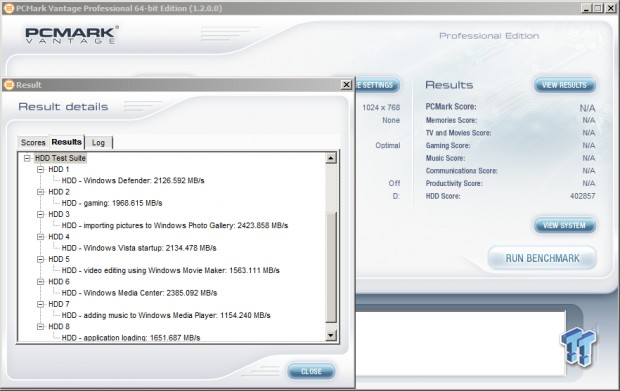
Intel P3608 on Z170 system:
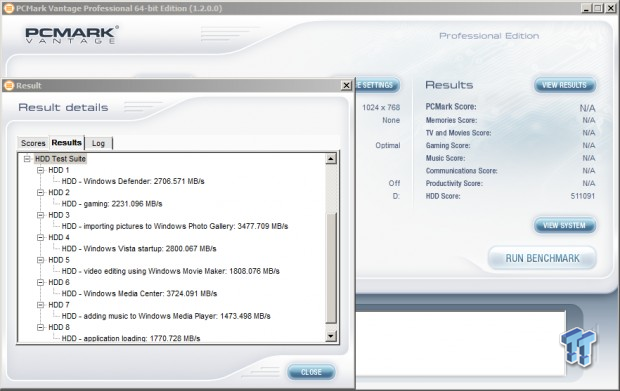
We chose Intel's P3608 running as a secondary volume to illustrate that even when it comes to straight CPU lanes, Z-series motherboards have a clear advantage over X-series motherboards (with regard to SSD performance), by as much as 20% in real-world type workloads. This holds true for SATA SSDs as well. Note: If these Vantage scores seem very high, they are, but if we introduce data on drive into the mix, there is no contest, the 950 Pro easily outperforms even a $3500 P3608 enterprise SSD with consumer workloads.
We are going to examine the performance of two bootable 950 Pro arrays, one featuring dual 512GB 950 Pro's, the other dual 256GB 950 Pro's. As mentioned, we don't see enough of an advantage by going to three drives due to DMI 3.0 bandwidth limitations to bother with running a three drive array.
We decided it would be fun to RAID all four of our 950 Pro's utilizing riser cards and straight CPU lanes in a soft RAID array to see what we could get out of them when they aren't held back by the chipset. We will present those results in our Maxed Out Performance (MOP) section.
Let's get into the review so we can show you why we believe that for the ultimate in OS disk performance, RAID 0 is back on top. We will be presenting screenshots of our dual 512GB 950 Pro array, and yes, it's our "C" drive, not a secondary volume like we've seen from others. We will briefly go over the BIOS settings necessary for a bootable PCIe array as well.
Drive Specifications
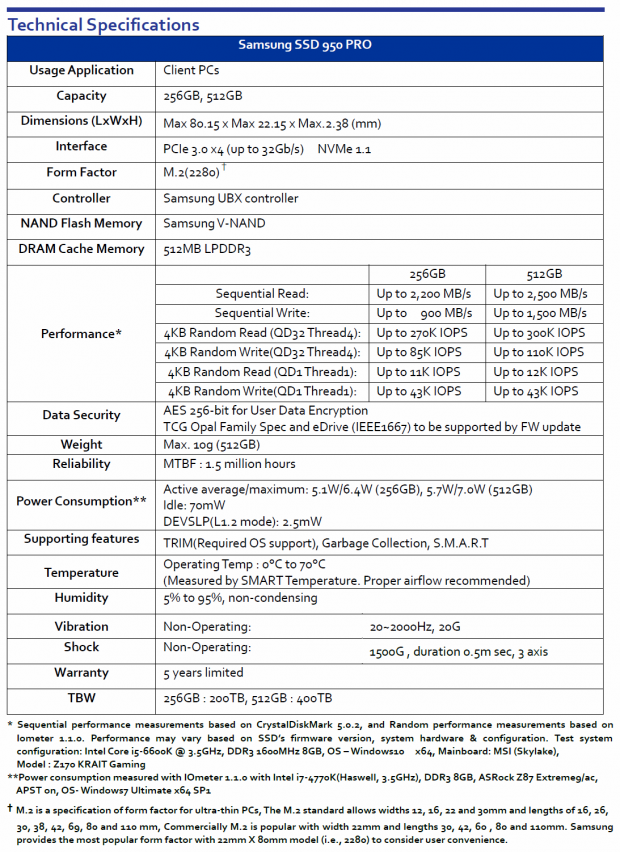
Samsung's 950 Pro NVMe SSD is available in two capacities: 256GB and 512GB. Sequential read performance varies by capacity up to 2500 MB/s maximum. Sequential write performance varies by capacity up to 1500 MB/s maximum. A single 950 Pro delivers up to 300,000 Random Read IOPS and 110,000 Random Write IOPS. 4K QD1 random read performance is listed at up to 12K IOPS. 4K QD1 random write performance is listed at up to 43K IOPS. LBA addressing is handled by a single Samsung 512MB LPDDR3 DRAM package at both capacity points. TBW (Total Bytes Written) checks in at 200TB for the 256GB capacity and 400TB for the 512GB model.
Samsung backs the 950 Pro with a five-year limited warranty. This is amazing endurance for an SSD with zero over-provisioning. However, if we mix in some OP, performance will increase, and endurance will go up exponentially. We will illustrate this with our data written testing.
Drive Details
Samsung 950 Pro M.2 PCIe Gen 3x4 NVMe SSD
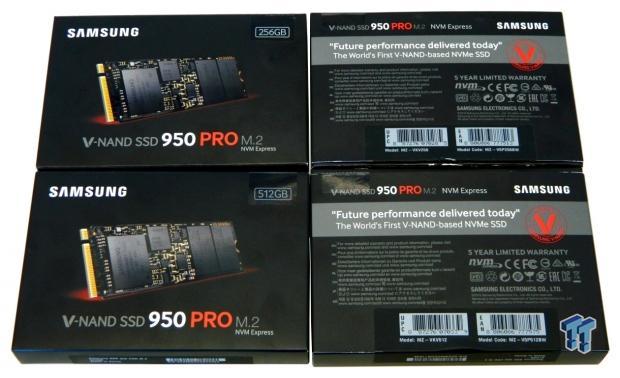
Samsung's 950 Pro retails in small black box with a picture of the drive on front. The drive's capacity is given on the top right corner of the box. The rear of the packaging informs us that the 950 Pro will deliver future performance today and that the 950 Pro is the world's first V-NAND-based NVMe SSD.
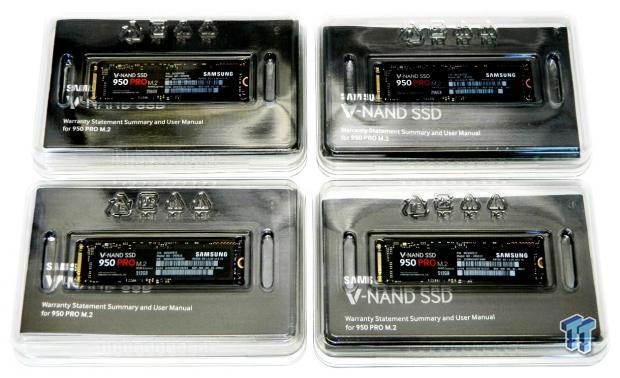
Inside the box, the drive is cradled in a clear plastic enclosure for protection.
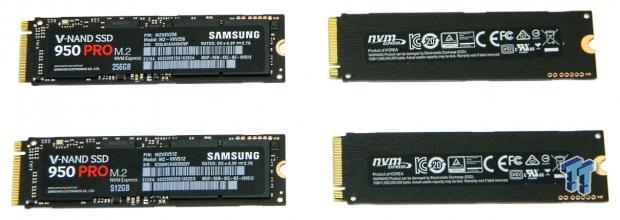
The front of the tiny black PCB is covered with a manufacturer's label. The label lists the drive's capacity, serial number, model number and other relevant information. The back half of the PCB is devoid of components.
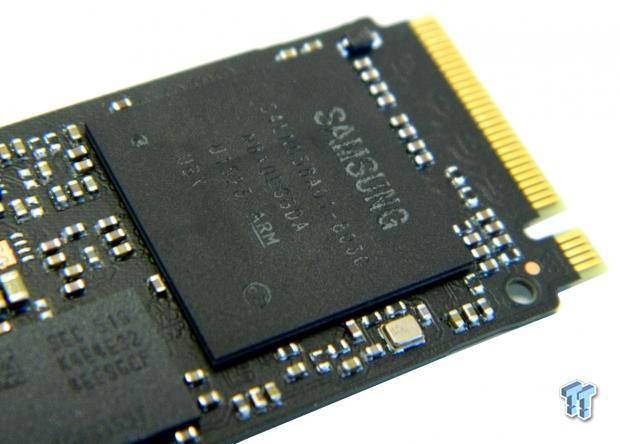
A tri-core ARM-based 8-channel Samsung UBX controller powers the 950 Pro. One core is dedicated to read operations, one to write operations, and one for host interaction.
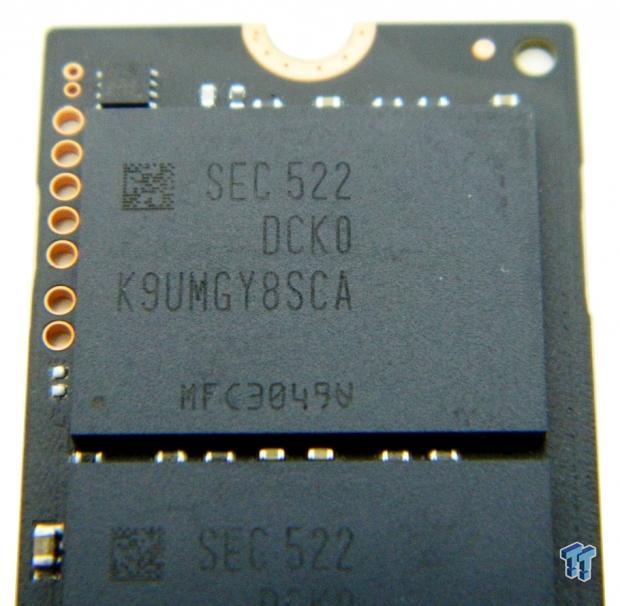
One of the drive's two V-NAND flash packages.
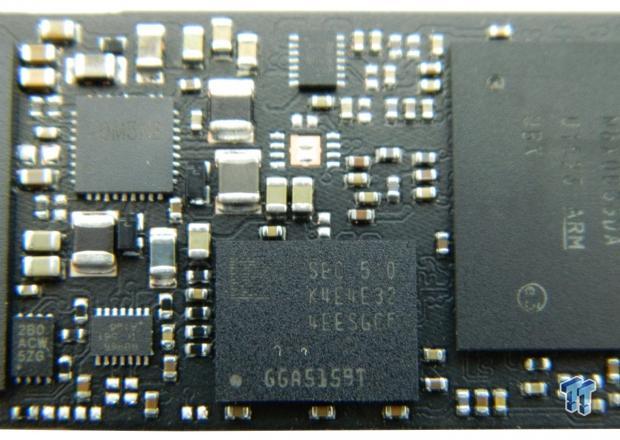
Finally, a close-in view of the drive's 512MB LPDDR3 Samsung DRAM cache package.
Test System Setup and Drive Properties
Jon's Consumer SSD Review Test System Specifications
- Motherboard: ASRock OC Formula Z170 - Buy from Amazon / Read our review
- CPU: Intel Core i7 6700K @ 4.7GHz - Buy from Amazon / Read our review
- Cooler: Swiftech H2O-320 Edge - Buy from Amazon / Read our review
- Memory: Corsair Vengeance LPX DDR4 16GB 3200MHz - Buy from Amazon
- Video Card: Onboard Video
- Case: IN WIN X-Frame - Buy from Amazon / Read our review
- Power Supply: Seasonic Platinum 1000 Watt Modular - Buy from Amazon / Read our review
- OS: Microsoft Windows 10 Professional 64-bit - Buy from Amazon
- Drivers: Intel RAID option ROM version 14.6.0.1029 and Intel RST driver version 14.8.0.1042
We would like to thank ASRock, Crucial, Intel, Corsair, RamCity, IN WIN, and Seasonic for making our test system possible.
Bootable PCIe RAID 0 Settings
We will briefly go over the settings we used to create a bootable PCIe array:
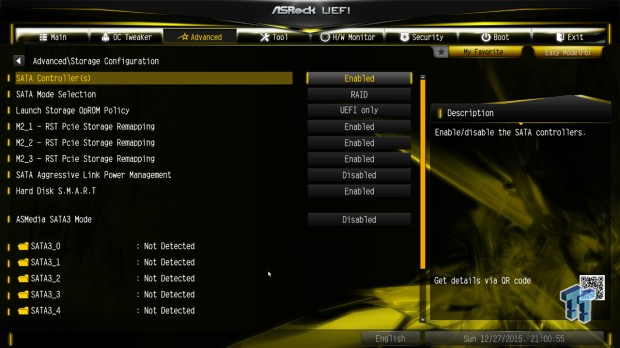
SATA mode needs to be set to RAID and RST PCIe storage remapping needs to be enabled.
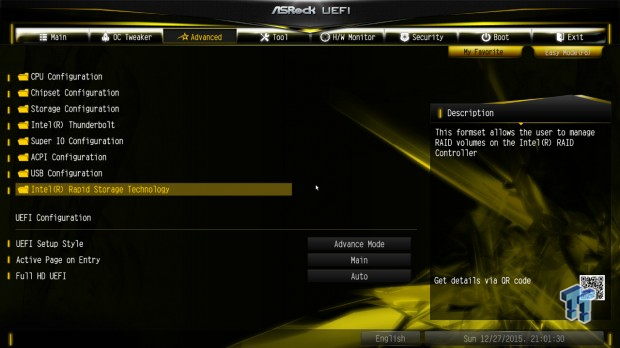
After a restart, Intel's Rapid Storage Technology will show up in advanced options.
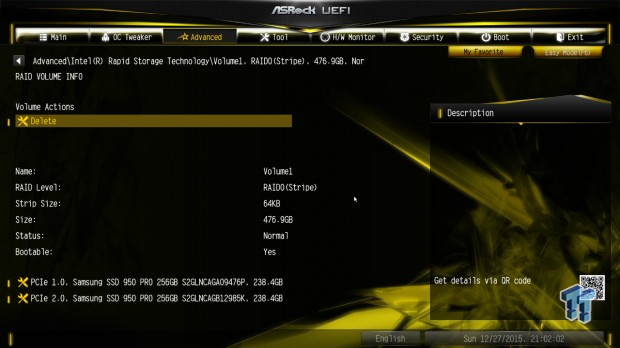
We used 64K stripes. We found that a 64K stripe size delivers better random and sequential performance than the default 16K.
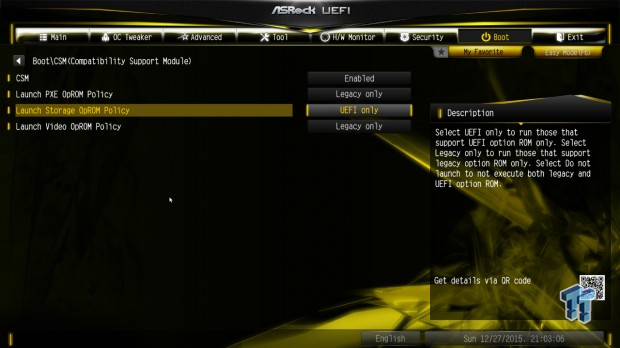
Storage OpROM policy needs to be set to boot UEFI only for a bootable array. Alternatively, you can disable CSM if your video card supports UEFI. You are ready to load Windows at this point, but you must have a compatible "F6" RST driver ready to load with Windows (we chose the latest version 14.8), or the array will not be recognized. Windows installer must be loaded as UEFI, so Windows is installed on a GPT partition.
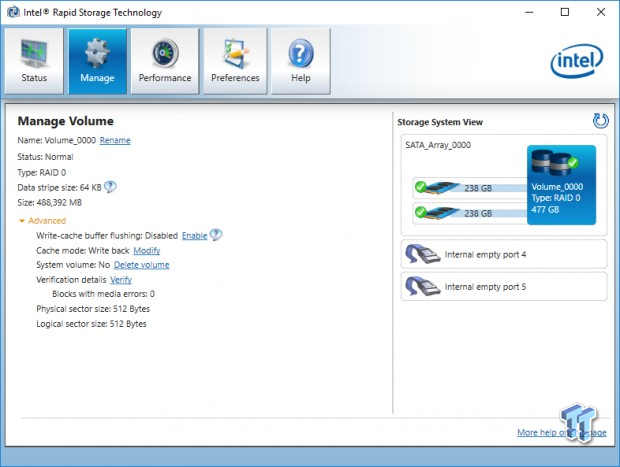
Once Windows is loaded, you will need to install the RST control panel to enable write-back caching, which is a must for superior performance.
Drive Properties
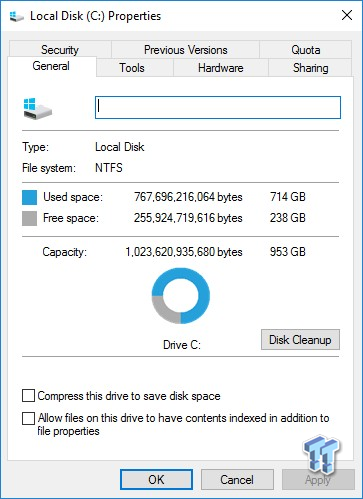
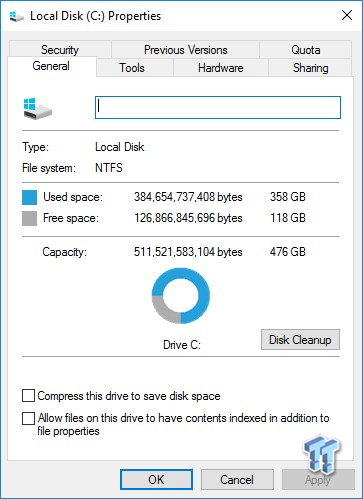
The majority of our testing is performed with our test drive as our boot volume. Our boot volume is 75% full for all OS Disk "C" drive testing to replicate a typical consumer OS volume implementation. We feel that most of you will be utilizing your SSDs for your boot volume and that presenting you with results from an OS volume is more relevant than presenting you with empty secondary volume results.
System settings: Cstates and Speed stepping are both disabled in our systems BIOS. Windows High-Performance power plan is enabled. Windows write caching is enabled, and Windows buffer flushing is disabled. We are utilizing Windows 10 Pro 64-bit for all of our testing except for our MOP (Maxed-Out Performance) benchmarks where we switch our OS to Windows Server 2008 R2 64-bit.
Blink of an eye boot speed
We got some pretty amazing boot speed out of our 950 Pro arrays; somewhat faster than a single drive.
Synthetic Benchmarks – ATTO & Anvil Storage Utilities
ATTO
Version and / or Patch Used: 3.05
ATTO is a timeless benchmark used to provide manufacturers with data used for marketing storage products.
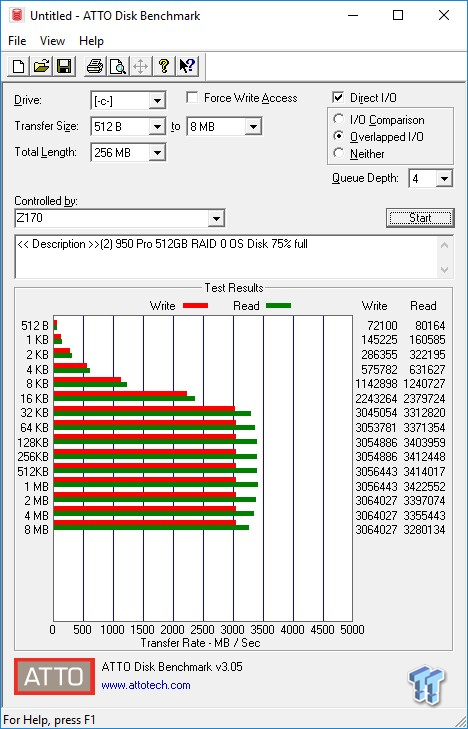
Sequential read/write transfers max out at 3422/3064 MB/s with our 512GB x 2 array. Keep in mind this is our OS volume 75% full.
Sequential Write
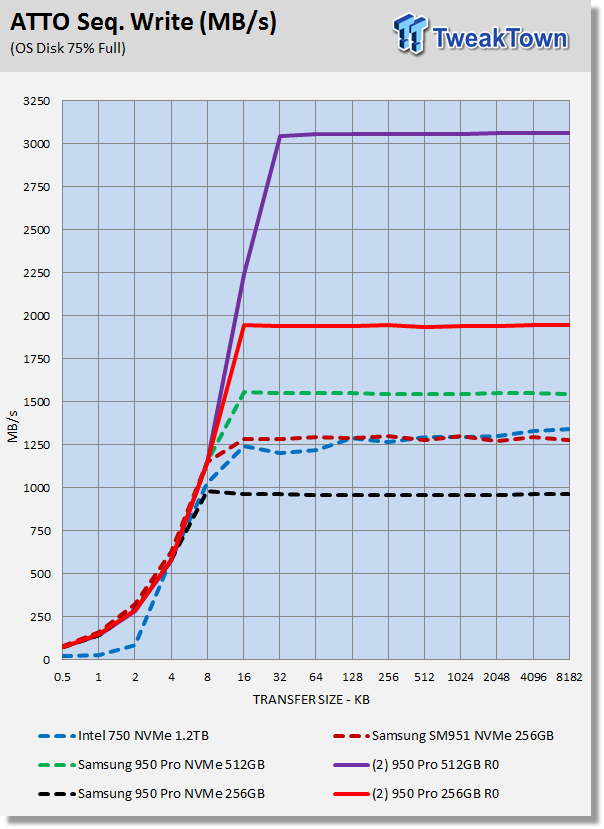
Both arrays provide nearly double the sequential performance of a single drive. DMI 3.0 isn't holding back sequential write speeds.
Sequential Read
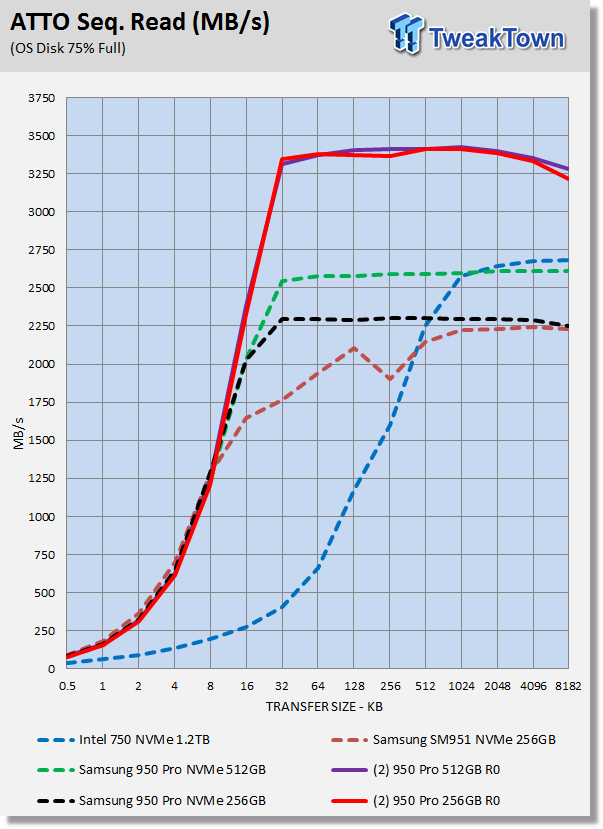
The chipset is severely limiting sequential read speeds, which would be about 5GB/s on CPU lanes, but then our arrays wouldn't be bootable.
Anvil Storage Utilities
Version and / or Patch Used: 1.1.0
Anvil's Storage Utilities is a storage benchmark designed to measure the storage performance of SSD's. The Standard Storage Benchmark performs a series of tests; you can run a full test or just the read or write test, or you can run a single test, i.e. 4k QD16.
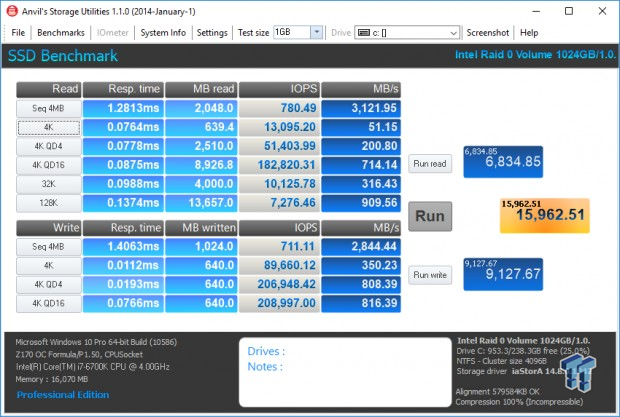
Scoring
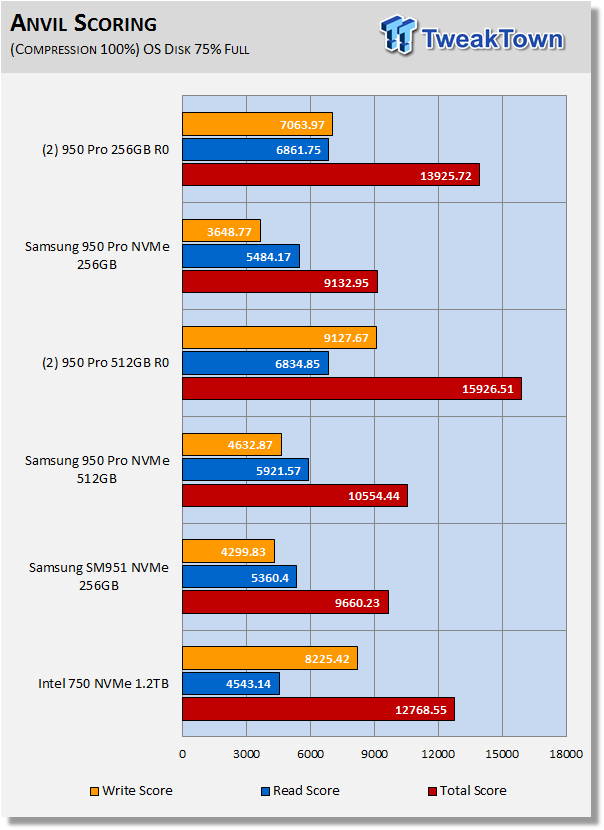
We note about a 50% increase in scoring from a single drive to a 2 drive array, with the majority coming from increased write performance.
(Anvil) Read IOPS through Queue Depth Scale
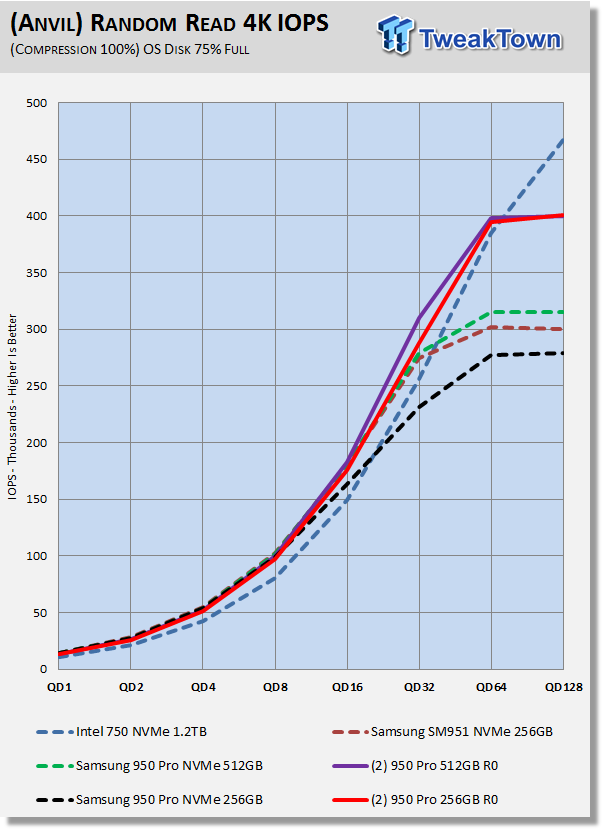
There isn't much of a difference between the performance of a single 950 Pro and a dual 950 Pro array until after QD8. At QD16 and above, the arrays deliver better performance with both arrays topping out at about 400K IOPS. Intel's 750 AIC (Add-In-Card) is able to hit 470K IOPS. At QD1-2, the 950 Pro arrays outperform the rest of the field.
(Anvil) Write IOPS through Queue Scale
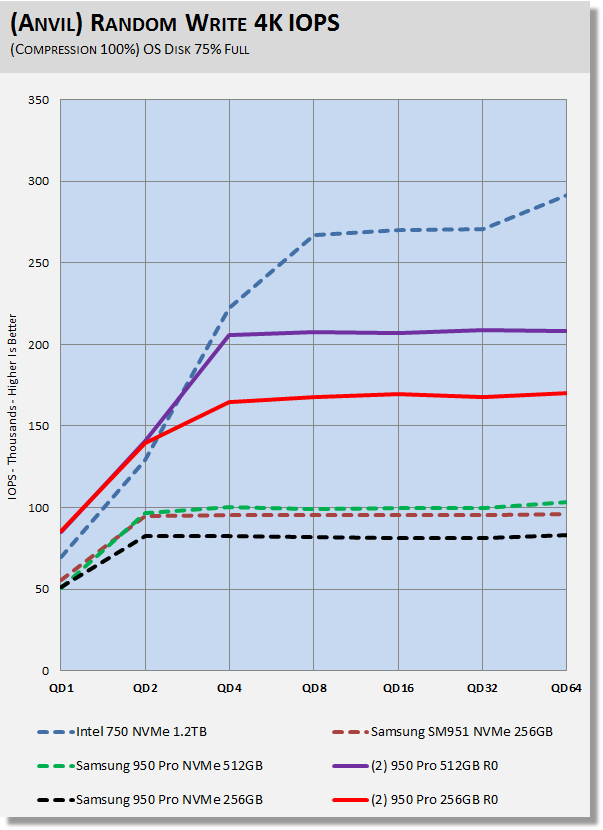
We are able to extract 170K IOPS from our dual 256GB 950 Pro array and 210K IOPS from our dual 512GB 950 Pro array. Both of these figures are about double that of a single drive. Intel's 750 AIC wins this round with a 290K IOPS performance.
Synthetic Benchmarks - CrystalDiskMark & AS SSD
CrystalDiskMark
Version and / or Patch Used: 3.0 Technical Preview
CrystalDiskMark is disk benchmark software that allows us to benchmark 4k and 4k queue depths with accuracy. Note: Crystal Disk Mark 3.0 Technical Preview was used for these tests since it offers the ability to measure native command queuing at QD4.
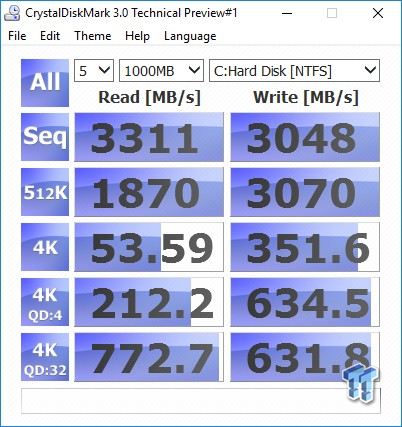
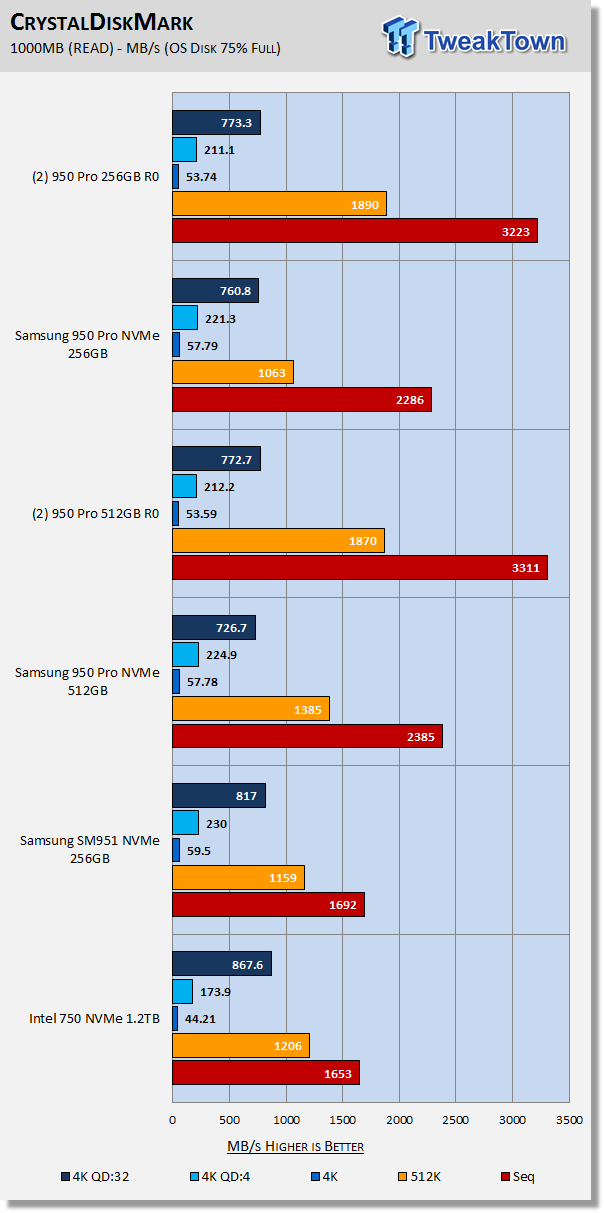
Both of our dual 950 Pro arrays are able to easily exceed 3GB/s sequential read speed. We notice a slight latency increase with an array when compared to a single drive at QD1 and QD4. We note a significant sequential read speed increase of nearly 600 MB/s for single a 256GB 950 Pro over the 256GB SM951, which is a testament to the power of 3D flash. At QD1 and QD4, the Samsung drives whether it be a single drive or an array, have a significant advantage over Intel's 750 series AIC.
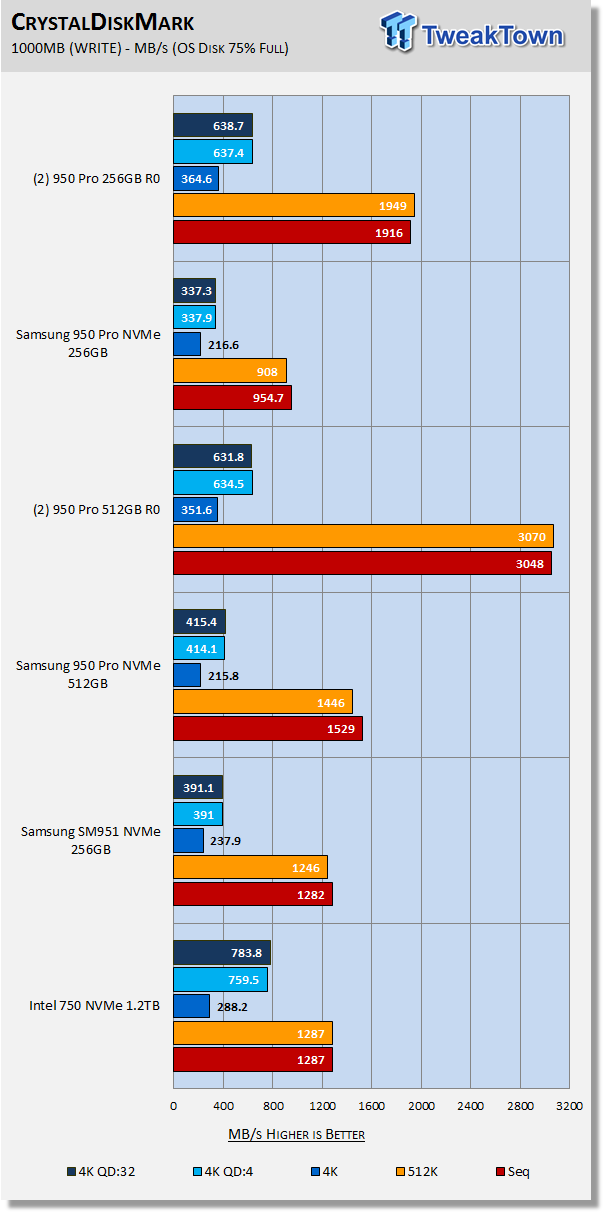
Write performance is where an array has a significant advantage over a single drive. In this case, the chipset isn't getting in the way of maximum performance. Our dual 256GB 950 Pro array has better random write performance than our dual 512GB 950 Pro array due to its higher cache to gigabyte ratio. In terms of pure sequential write performance, our dual 512GB 950 Pro array runs away with this test.
AS SSD
Version and / or Patch Used: 1.7.4739.38088
AS SSD determines the performance of Solid-State Drives (SSD). The tool contains four synthetic as well as three practice tests. The synthetic tests are to determine the sequential and random read and write performance of the SSD.
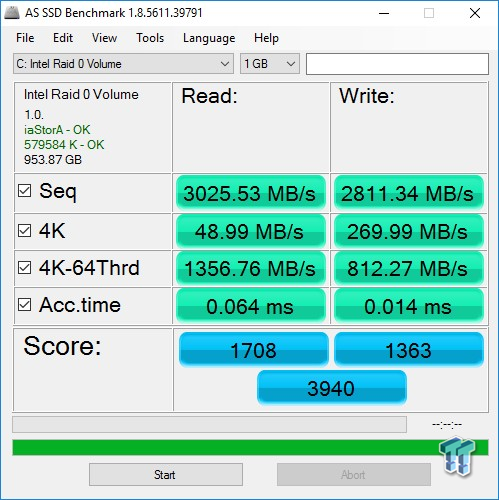
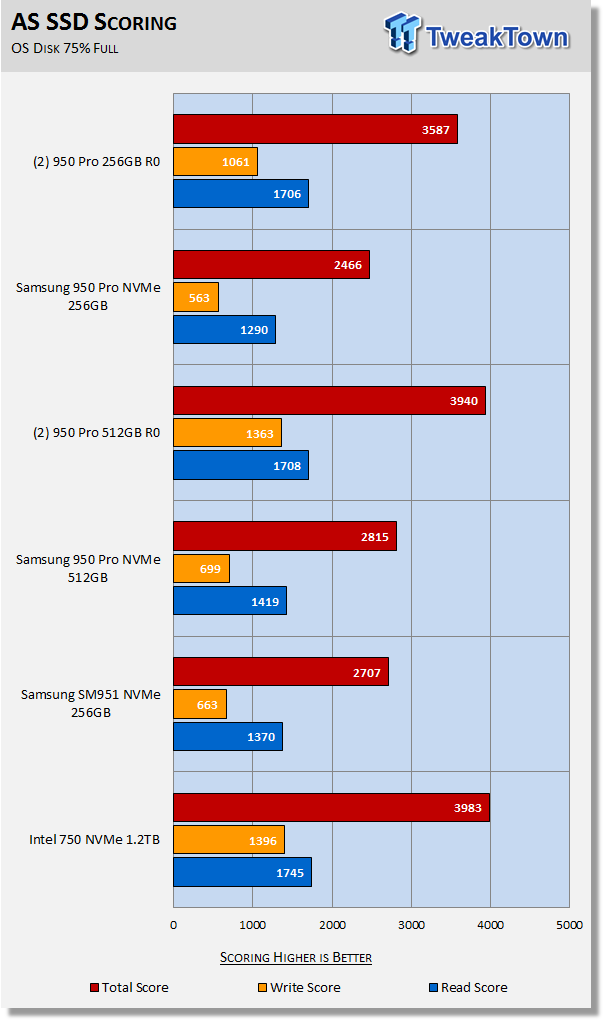
So much of AS SSD's scoring comes from 4K-64 thread performance (which is nearly irrelevant in a consumer setting) that scoring may not reflect what can be expected in terms of real-world performance. We still bench with AS SSD because it's a very popular test that many enthusiasts use and scoring aside, it does provide important data.
With our synthetic testing out of the way, let's take a look at our moderate workload testing.
Benchmarks (Trace-Based OS Volume) - PCMark Vantage, PCMark 7 & PCMark 8
Moderate Workload Model
We categorize these tests as indicative of a moderate workload environment.
PCMark Vantage - Hard Disk Tests
Version and / or Patch Used: 1.2.0.0
The reason we like PCMark Vantage is because the recorded traces are played back without system stops. What we see is the raw performance of the drive. This allows us to see a marked difference between scoring that other trace-based benchmarks do not exhibit. An example of a marked difference in scoring on the same drive would be empty vs. filled vs. steady state.
We run Vantage three ways. The first run is with the OS drive 75% full to simulate a lightly used OS volume filled with data to an amount we feel is common for most users. The second run is with the OS volume written into a "Steady State" utilizing SNIA's guidelines. Steady state testing simulates a drives performance similar to that of a drive that been subjected to consumer workloads for extensive amounts of time. The third run is a Vantage HDD test with the test drive attached as an empty secondary storage device.
OS Volume 75% Full - Lightly Used
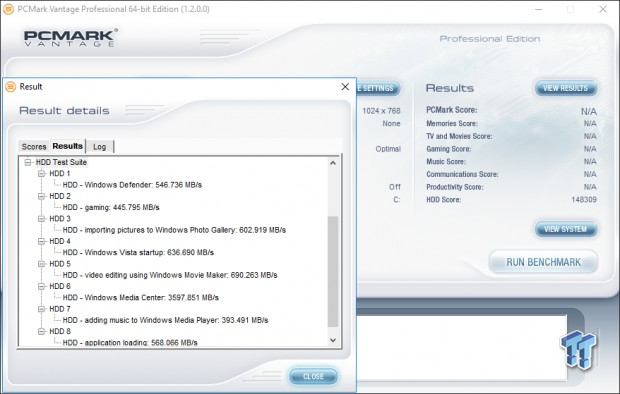
OS Volume 75% Full - Steady State
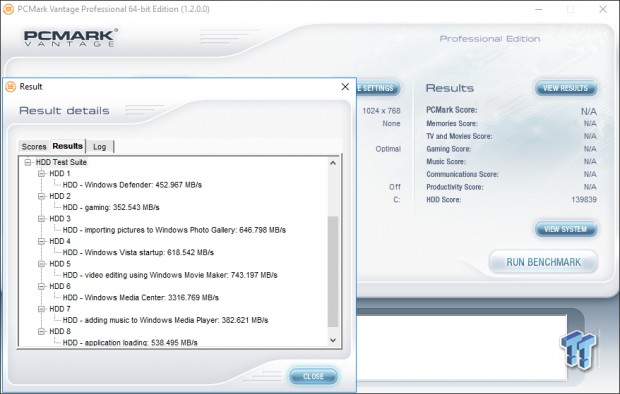
Secondary Volume Empty - FOB
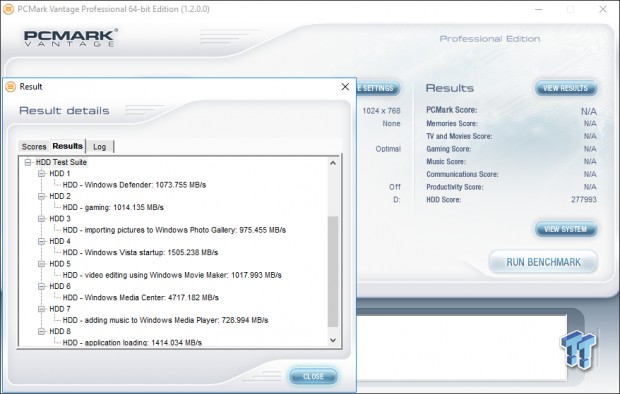
There's a big difference between an empty drive, one that's 75% full/used, and one that's in a steady state.
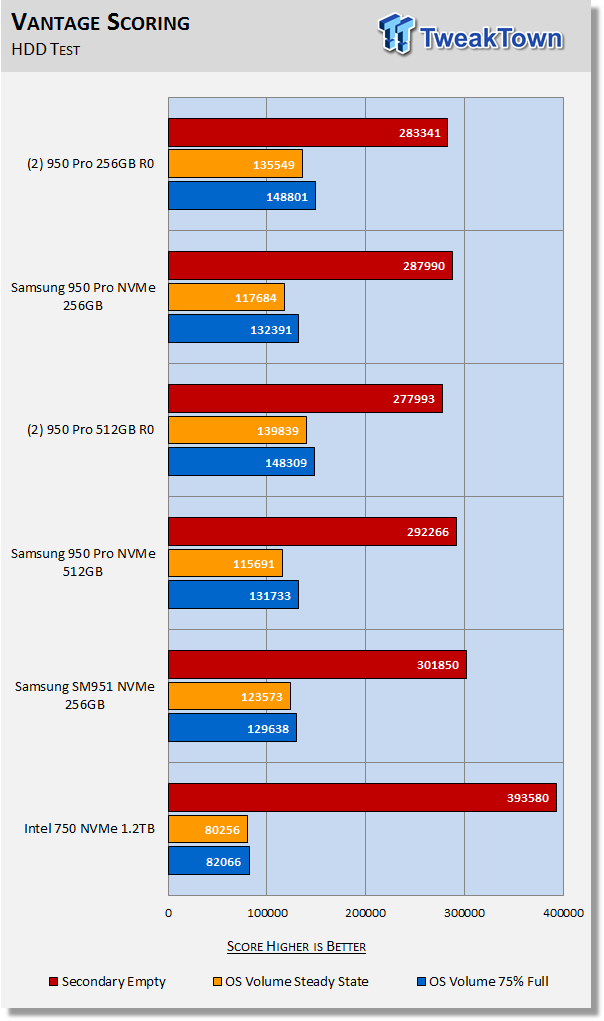
The important scores to pay attention to are "OS Volume Steady State" and "OS Volume 75% full." These two categories are most important because they are indicative of typical of consumer user states. When a drive is in a steady state, it means garbage collection is running at the same time it's reading/writing. This is exactly why we focus on steady state performance.
We notice a nice steady-state performance increase with both of our arrays over a single drive. In an empty FOB state, which is totally unrealistic, a single 950 Pro delivers a better score. To illustrate how unrealistic an empty FOB score really is, we only need to look at the Intel 750's results.
Intel's 750 scores almost 400K when it's empty, but when we load up the 750 with data, a totally different picture emerges with scoring dropping to 80K. The 750 goes from a solid first to a solid last. This is why we test with data on the drive for a more realistic evaluation. This holds true for most of the tests we run. If we were to run our testing with empty secondary volumes, most of our test results would be significantly higher.
PCMark 7 - System Storage
Version and / or Patch Used: 1.4.0
We will look to Raw System Storage scoring for evaluation because it's done without system stops and, therefore, allows us to see significant scoring differences between drives.
OS Volume 75% Full - Lightly Used
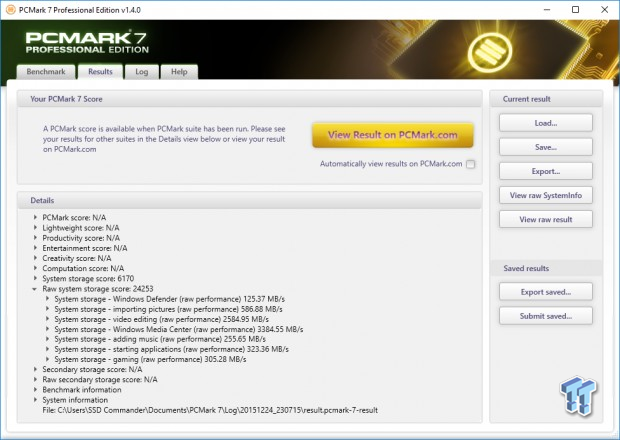
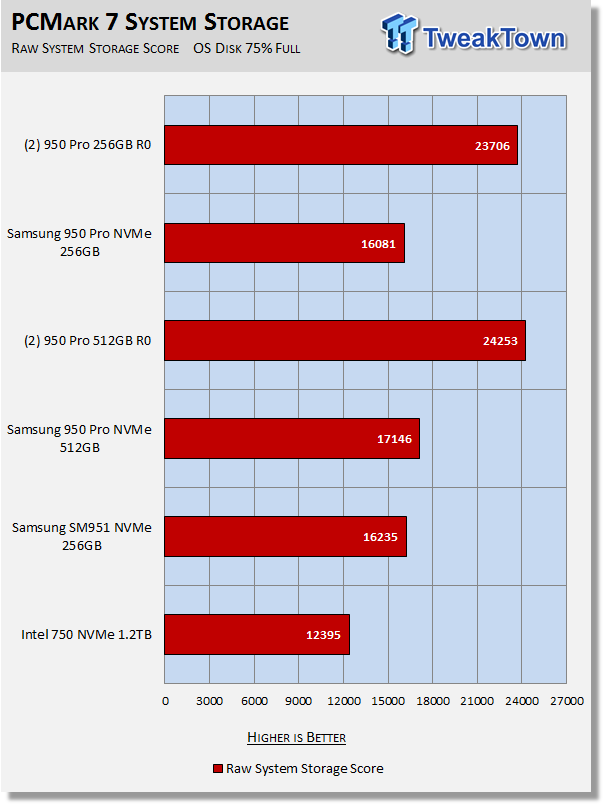
PCMark 7 is showing an increase of about 40% for a 950 Pro array over a single drive. This backs up what we saw from Vantage. All the Samsung offerings easily outperform Intel's 750 Series by a significant margin with the greatest disparity coming from our dual 512GB 950 Pro array, where it outperforms the 750 by almost 100%.
PCMark 8 - Storage Bandwidth
Version and / or Patch Used: 2.5.419
We use PCMark 8 Storage benchmark to test the performance of SSDs, HDDs, and hybrid drives with traces recorded from Adobe Creative Suite, Microsoft Office, and a selection of popular games. You can test the system drive or any other recognized storage device, including local external drives. Unlike synthetic storage tests, the PCMark 8 Storage benchmark highlights real-world performance differences between storage devices.
OS Volume 75% Full - Lightly Used
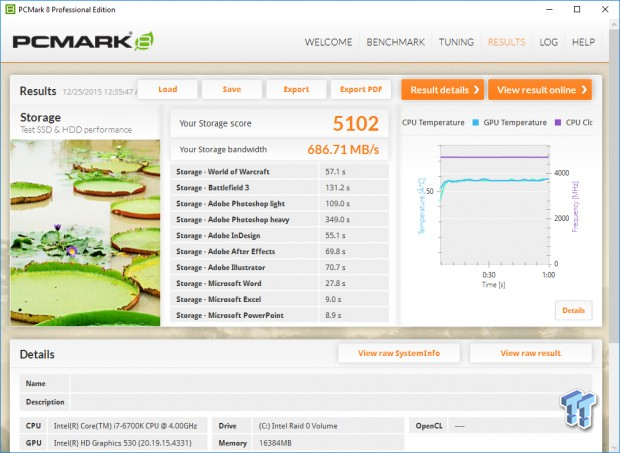
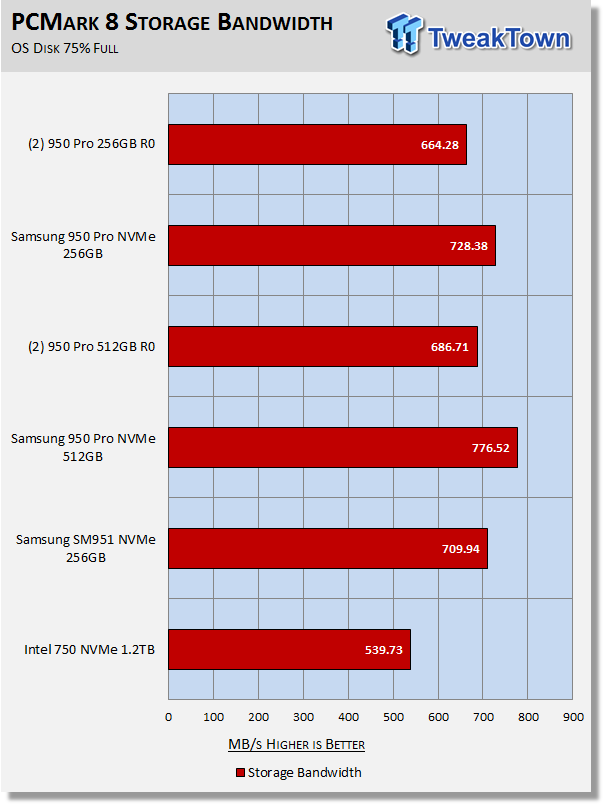
PCMark 8 is the most intensive moderate workload simulation we run. For the first time in our round of testing, a single drive is able to best an array. This is most certainly a result of a single 950 Pro having better 4K QD1 read performance than an array does. As we will see this is an anomaly that doesn't hold true for any of our other tests.
Again we see that the 950 Pro handily outperforms Intel's 750 Series in an OS environment. We also note that the 256GB 950 Pro outperforms the SM951 in real-world type testing despite the fact that the 256GB SM951 outperforms it in synthetic testing.
Benchmarks (Secondary Volume) - Max IOPS, Disk Response & Transfer Rates
Iometer – Maximum IOPS
Version and / or Patch Used: Iometer 2014
We use Iometer to measure high queue depth performance. (No Partition)
Max IOPS Read 8-Workers (FOB) QD 256 8GB LBA
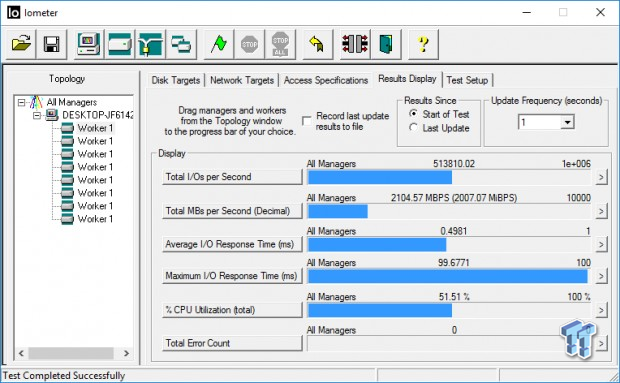
Max IOPS Write 8-Workers (FOB) QD 256 8GB LBA
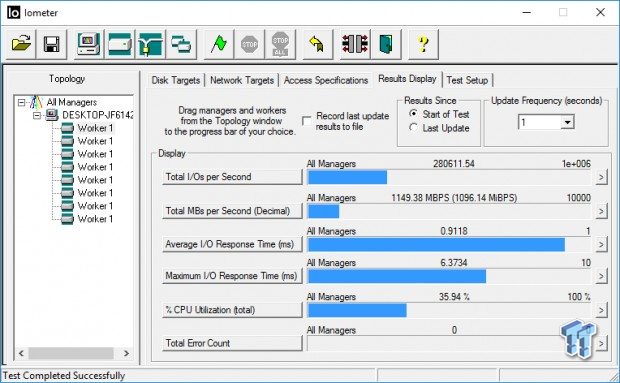
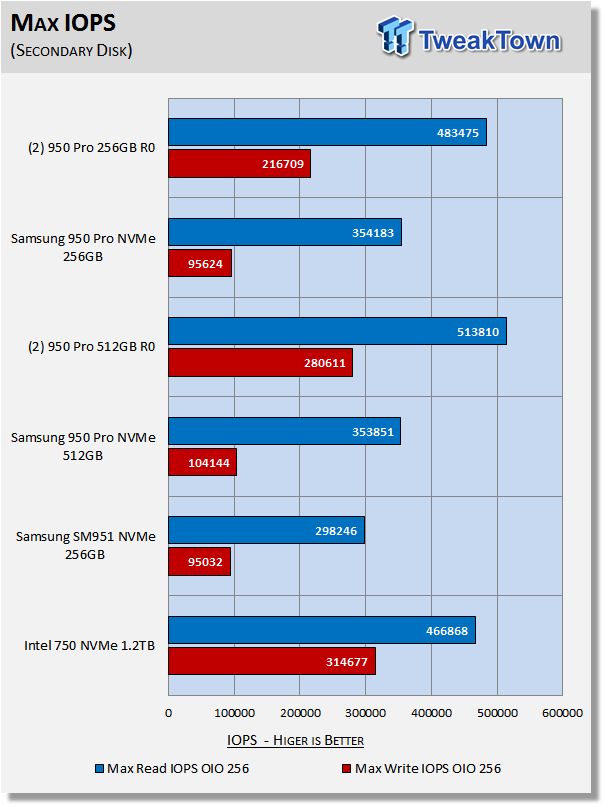
We run this test at QD256, which is a queue depth that a consumer SSD will never see. We do this just to see what the maximum attainable IOPS from our configuration actually is. We notice that in the case of our dual 512GB 950 Pro array, the array is capable of pumping out nearly three times the performance of a single 512GB 950 Pro.
This is the effect of RST write-back caching and is a very good example of why you want to enable it. At enterprise queue depths, Intel's 750 delivers superior write performance. Now let's see what performance looks like at the opposite end of the spectrum, QD1, with our disk response testing.
Iometer – Disk Response
Version and / or Patch Used: Iometer 2014
We use Iometer to measure disk response times. Disk response times are measured at an industry accepted standard of 4K QD1 for both write and read. Each test runs twice for 30 seconds consecutively, with a 5-second ramp-up before each test. We partition the drive/array as a secondary device for this testing.
Avg. Write Response
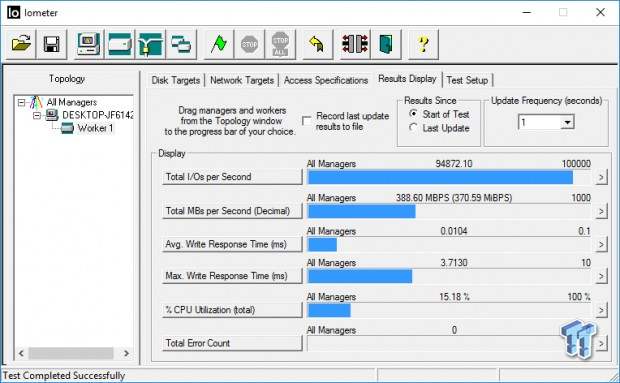
Avg. Read Response
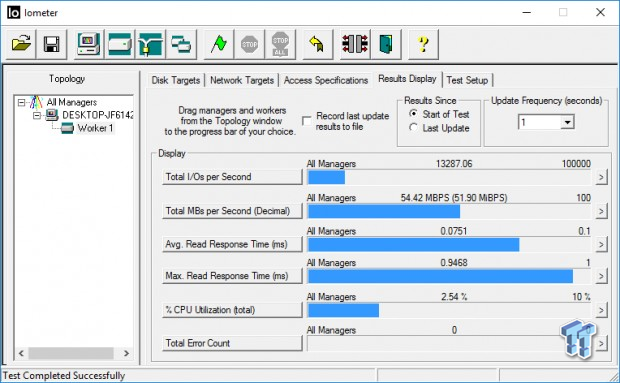
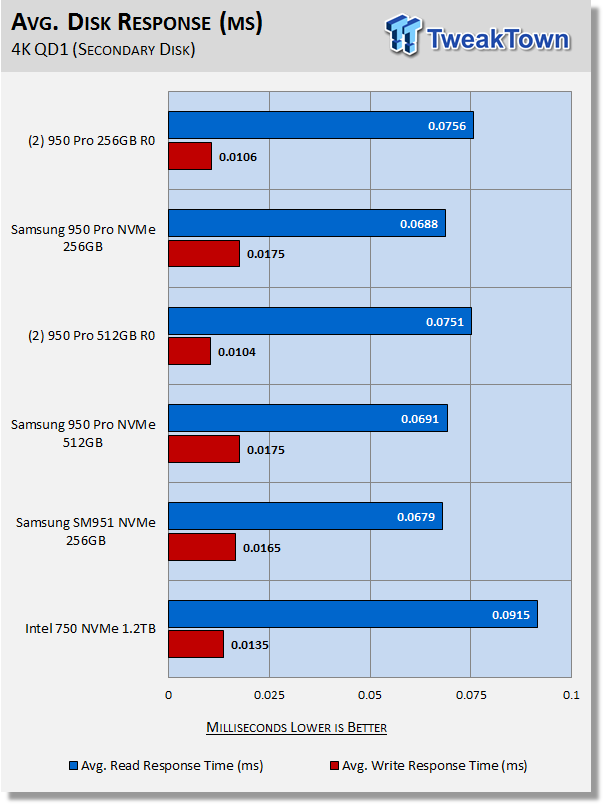
This is exactly what we saw from our synthetic testing. A single 950 Pro has better QD1 read performance than an array. This is common to all arrays we've tested over the years. Write response is another matter though (when write-back caching is enabled). A dual drive array delivers a 40% increase in QD1 write performance over a single 950 Pro.
This is significantly better performance and another benchmark we can point to as a reason why we believe a 950 Pro array is currently the best performing OS disk available.
DiskBench - Directory Copy
Version and / or Patch Used: 2.6.2.0
We use DiskBench to time a 28.6GB block (9,882 files in 1,247 folders) composed primarily of incompressible sequential and random data as it's transferred from our DC P3700 PCIe NVME SSD to our test drive. We then read from a 6GB zip file that's part of our 28.6GB data block to determine the test drives read transfer rate. Our system is restarted prior to the read test to clear any cached data, ensuring an accurate test result.
Transfer Rates
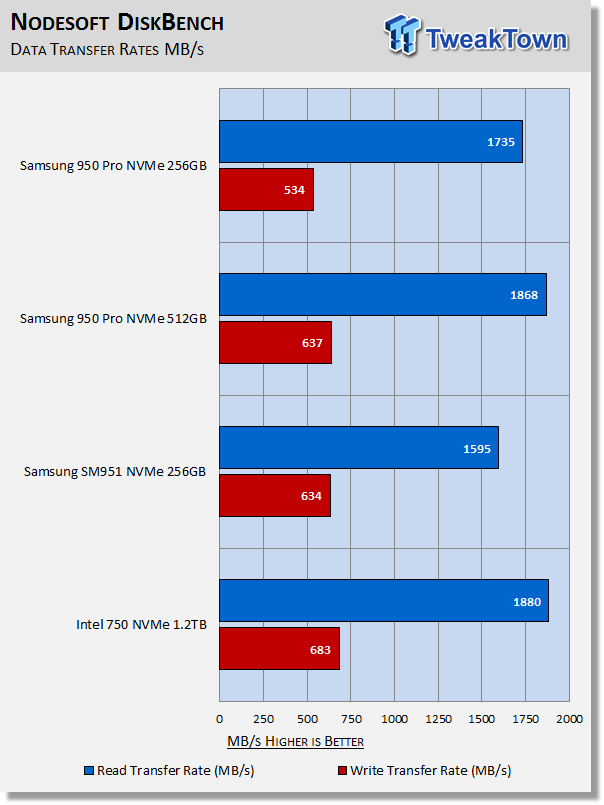
We only tested single drive performance because we aren't sure that we have anything fast enough to feed our arrays. In a single drive setting, Intel's 750 delivers the best transfer rates.
Benchmarks (Secondary Volume) - PCMark 8 Extended
Futuremark PCMark 8 Extended
Heavy Workload Model
PCMark 8's consistency test simulates an extended duration heavy workload environment. PCMark 8 has built-in, command line executed storage testing. The PCMark 8 Consistency test measures the performance consistency and the degradation tendency of a storage system.
The Storage test workloads are repeated. Between each repetition, the storage system is bombarded with a usage that causes degraded drive performance. In the first part of the test, the cycle continues until a steady degraded level of performance has been reached. (Steady State)
In the second part, the recovery of the system is tested by allowing the system to idle and measuring the performance after 5-minute long intervals. (Internal drive maintenance: Garbage Collection (GC)) The test reports the performance level at the start, the degraded steady-state, and the recovered state, as well as the number of iterations required to reach the degraded state and the recovered state.
We feel Futuremark's Consistency Test is the best test ever devised to show the true performance of solid state storage in an extended duration heavy workload environment. This test takes on average 13 to 17 hours to complete and writes somewhere between 450GB and 14,000GB of test data depending on the drive. If you want to know what an SSD's steady state performance is going to look like during a heavy workload, this test will show you.
Here's a breakdown of Futuremark's Consistency Test:
Precondition phase:
1. Write to the drive sequentially through up to the reported capacity with random data.
2. Write the drive through a second time (to take care of overprovisioning).
Degradation phase:
1. Run writes of random size between 8*512 and 2048*512 bytes on random offsets for 10 minutes.
2. Run performance test (one pass only).
3. Repeat 1 and 2 for 8 times, and on each pass increase the duration of random writes by 5 minutes.
Steady state phase:
1. Run writes of random size between 8*512 and 2048*512 bytes on random offsets for 50 minutes.
2. Run performance test (one pass only).
3. Repeat 1 and 2 for 5 times.
Recovery phase:
1. Idle for 5 minutes.
2. Run performance test (one pass only).
3. Repeat 1 and 2 for 5 times.
Storage Bandwidth
PCMark 8's Consistency test provides a ton of data output that we use to judge a drive's performance.
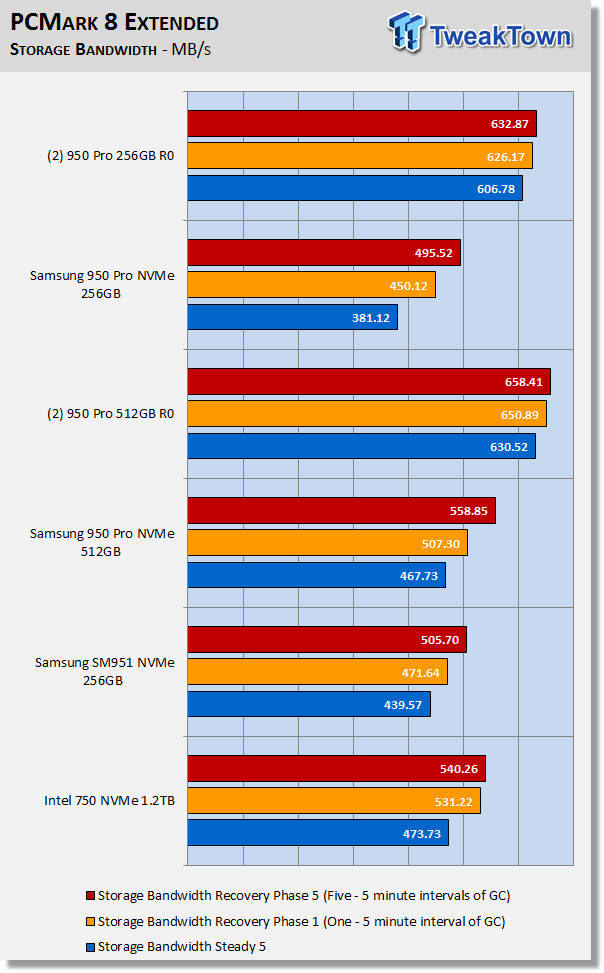
We consider steady state bandwidth (the blue bar) our test that carries the most weight in ranking a drive/arrays heavy workload performance. Performance after Garbage Collection (GC) (the orange and red bars) is what we consider the second most important consideration when ranking a drives performance. Trace-based steady state testing is where true high performing SSDs are separated from the rest of the pack.
We wanted to see how an enterprise like version of a 950 Pro array would perform. We accomplished this by building a 20% OP into our arrays (this is the ONLY test where we over-provisioned). Although not charted, we can tell you that 20% over-provisioning delivers about a 50 MB/s increase over a non-overprovisioned array across the board.
Over-provisioned or not, this is a huge increase in performance over a single drive in a heavy workload environment. This is the opposite of what we saw from our standard PCMark 8 testing. Do you need solid proof that a 950 Pro array is the currently best OS disk? This is it. Especially when you over-provision the array.
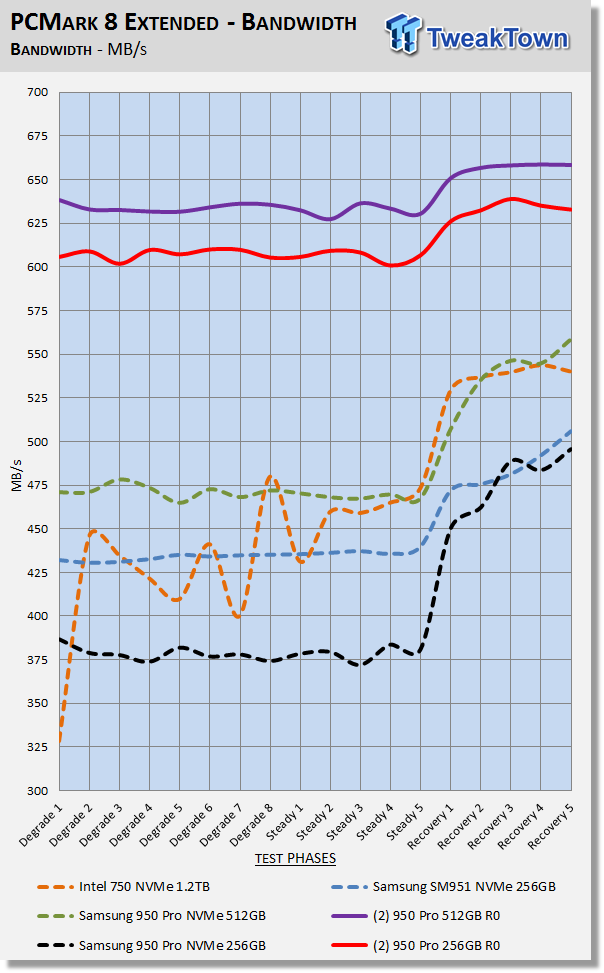
We chart our test subject's storage bandwidth as reported at each of the test's 18 trace iterations. This gives us a good visual perspective of how our test subjects perform as testing progresses. What jumps out at us is just how little performance variability in degrade and steady-state phases of the test the Samsung drives display.
Intel's 750 produces a pronounced wave pattern displaying significant variability. This chart makes it very clear that overall a single 512GB 950 Pro is easily outperforming the 1.2TB 750 series in terms of storage bandwidth for 85% of the entire test. The performance of both 950 Pro arrays is downright amazing!
Total Access Time (Latency)
We chart the total time the disk is accessed as reported at each of the test's 18 trace iterations.
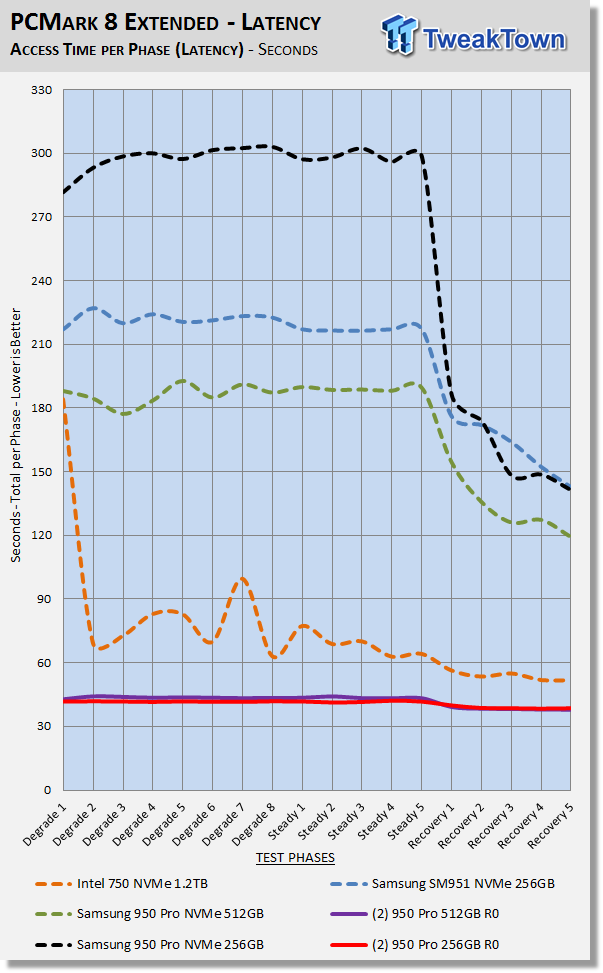
Look at what over-provisioning can do from a latency prospective. Our dual 256GB 950 Pro array with 20% overprovisioning has seven times lower latency than a single drive.
Disk Busy Time
Disk Busy Time is how long the disk is busy working. We chart the total time the disk is working as reported at each of the tests 18 trace iterations.
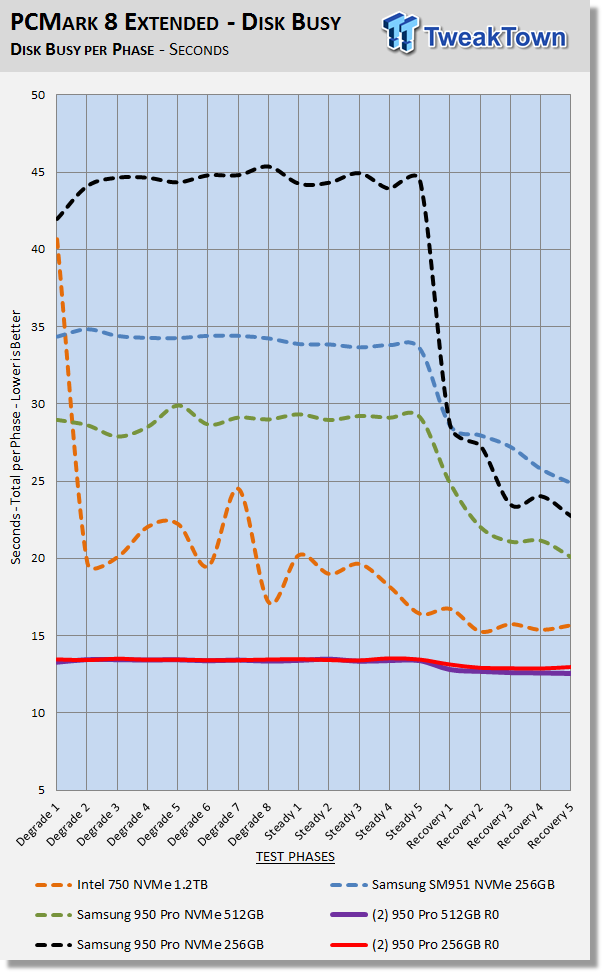
When latency is low, disk busy time is low as well.
Data Written
We measure the total amount of random data that our test drive/array is capable of writing during the degradation phases of the consistency test. Pre-conditioning data is not included in the total. The total combined time that degradation data is written to the drive/array is 470 minutes. This can be very telling. The better a drive/array can process a continuous stream of random data, the more data will be written.
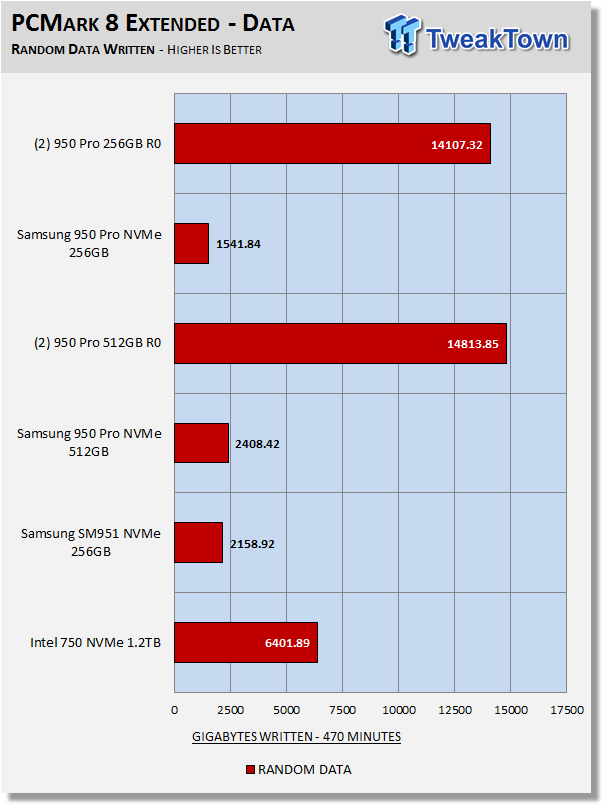
This test is the real reason we wanted to show what over-provisioning can do. The Intel 750 has OP built-in, which is why it can write so much more random data than a single 950 Pro without any OP. We used 20% OP on our 950 Pro arrays which resulted in up to nine times the data being written in comparison to a single non-over-provisioned 950 Pro. Although not charted, without OP, a 950 Pro array is able to write 2-3x the data of a single non-over-provisioned 950 Pro.
In terms of sustained random write performance, over-provisioning is the main difference between an enterprise SSD and a consumer SSD. We can clearly see why manually over-provisioning an SSD that doesn't have any built-in is advantageous.
Benchmarks (Secondary Volume) – 70/30 Mixed Workload
70/30 Mixed Workload Test (Sledgehammer)
Version and / or Patch Used: Iometer 2014
Heavy Workload Model
This test hammers a drive so hard we've dubbed it "Sledgehammer". Our 70/30 Mixed Workload test is an enterprise-class test designed to simulate a heavy-duty workstation steady-state environment. We feel that a mix of 70% read/30% write, full random 4K transfers best represents this type of user environment. Our test allows us to see the drive enter into and reach a steady state as the test progresses.
Phase one of the test preconditions the drive for 1 hour with 128K sequential writes. Phase two of the test runs a 70% read/30% write, full random 4K transfer workload on the drive for 1 hour. We log and chart (phase two) IOPS data at 5-second intervals for 1 hour (720 data points). 60 data points = 5 minutes.
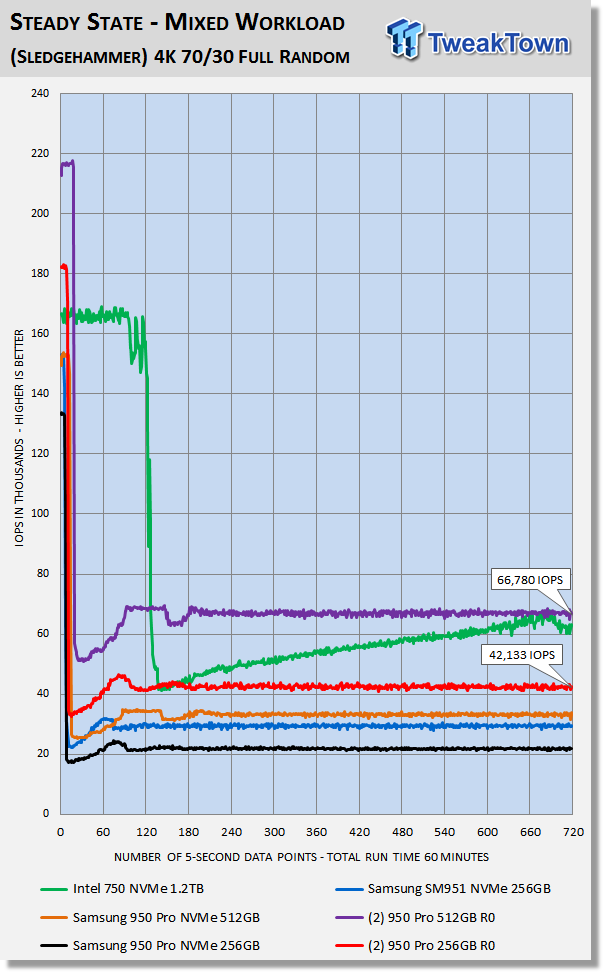
What we like about this test is that it reflects reality. Everything lines up, as it should. Consumer drives don't outperform Enterprise-Class SSDs that were designed for enterprise workloads. Consumer drives based on old technology are not outperforming modern Performance-Class SSDs, etc.
Our dual 512GB 950 Pro array takes the win in this round of our testing. Intel's 750 finishes a close second, followed by the dual 256GB 950 Pro array. Adding a second drive into the mix doubles the performance with this demanding workload. Steady-state for both arrays is achieved at about 1,100 seconds into the 3,600 second run. With more time, the 750 may have caught our dual 512GB 950 Pro array, but it severely lagged behind for most of the test.
Maxed-Out Performance (MOP)
This testing is just to see what the drive is capable of in an FOB (Fresh Out of Box) state under optimal conditions which is for the most part how most reviewers run these tests. We are utilizing Windows Server 2008 R2 64-bit for this testing. Same Hardware, just an OS change.
We wanted to see what we could get out of all four of our 950 Pro's running on CPU lanes. We created a 1TB MS Soft RAID striped array utilizing standard settings. The two 256GB drives are limiting the overall array performance somewhat, but the results are none-the-less very impressive. This type of array is not bootable.
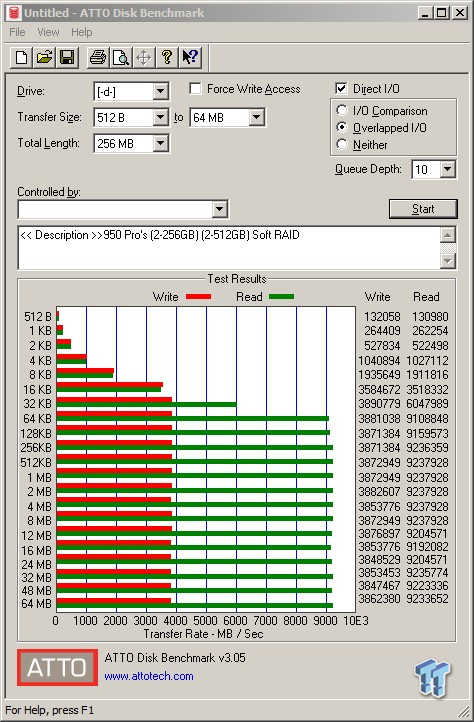
9.2 GB/s sequential read, 3.8 GB/s sequential write. The smaller drives are reducing the write speed of the larger. If we used four 512GB drives, we would see sequential write speeds north of 5 GB/s.
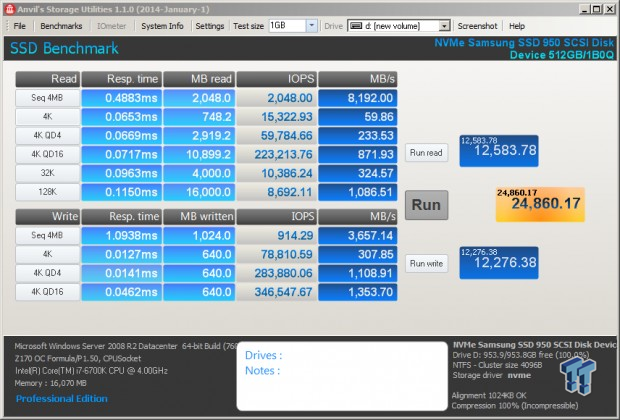
Approaching a score of 25,000.
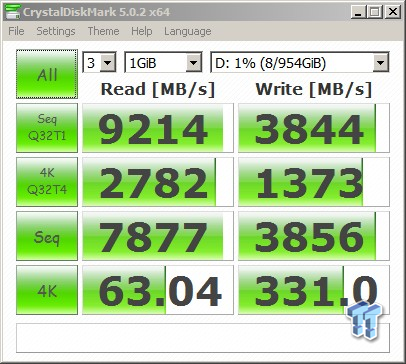
9.2 GB/s sequential read, 3.8 GB/s sequential write. 63 MB/s 4K QD1 random read.
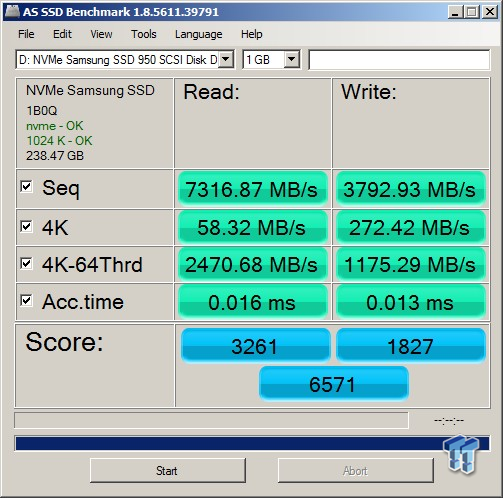
Combined scoring: 6,500 Points.
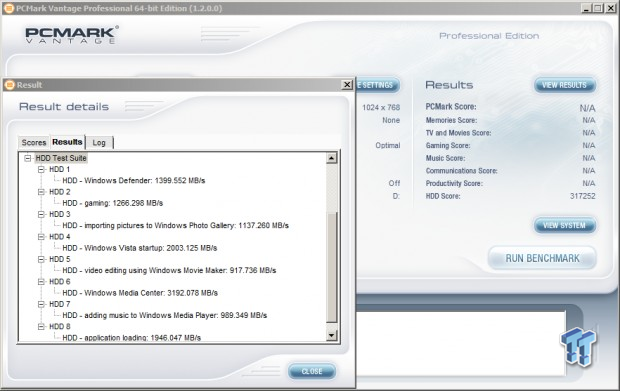
HDD score: 317,000
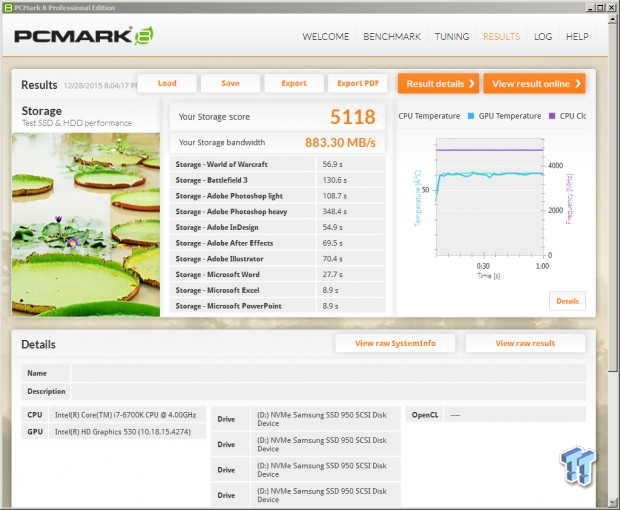
Storage Bandwidth: 883 MB/s
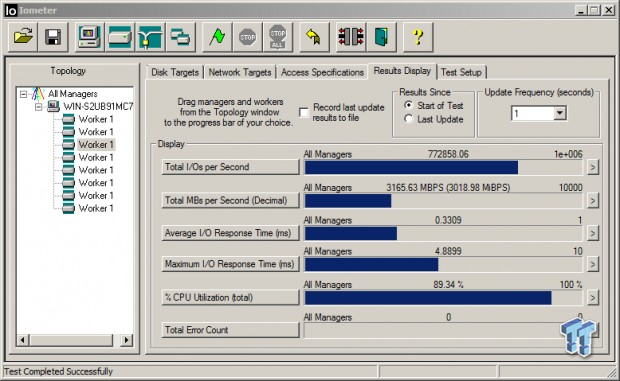
Max 4K Random Read IOPS: 772,000 (89% CPU Utilization)
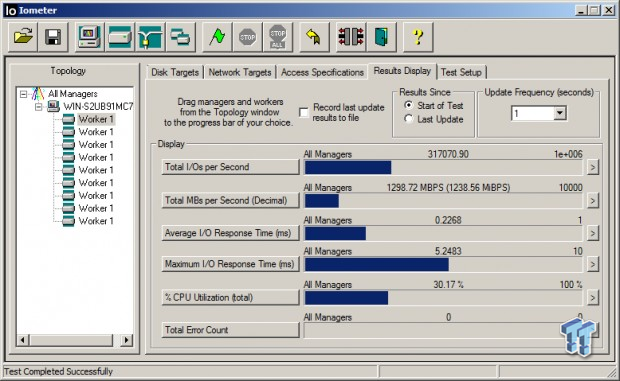
Max Random Write IOPS: 317,000 (30% CPU Utilization)
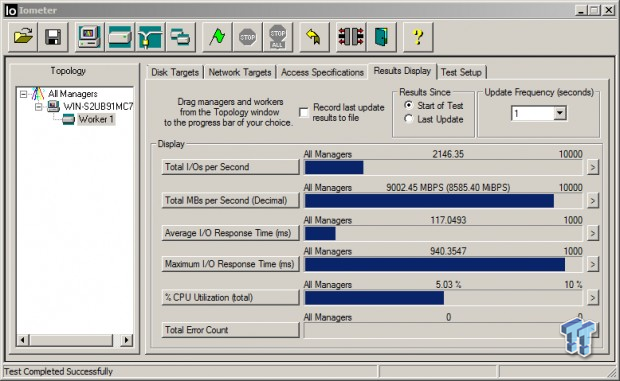
9 GB/s Sequential Read. (5% CPU Utilization)
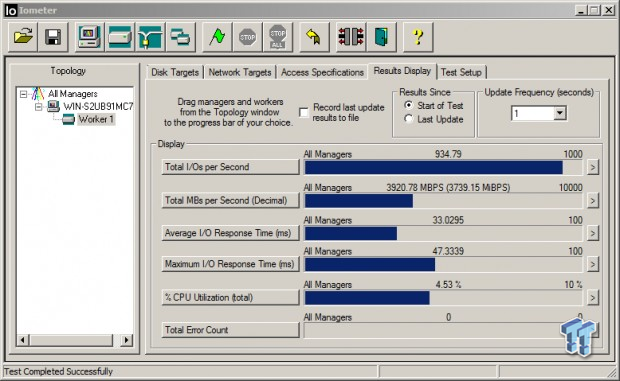
3.9 GB/s Sequential Write. (4.5% CPU Utilization)
Final Thoughts
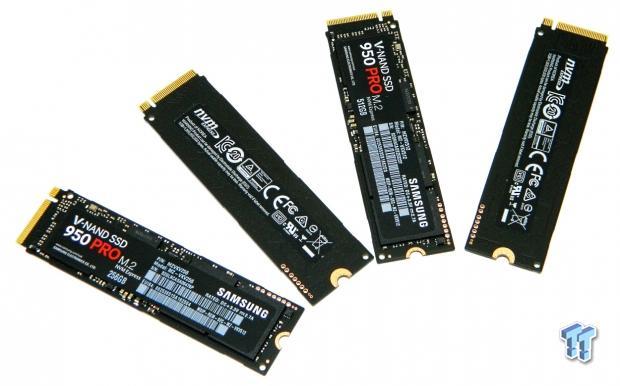
Throughout our testing, we saw compelling performance from both of our dual drive 950 Pro arrays. There really is no question in our minds; a bootable PCIe array makes for the ultimate operating system disk. Some of you will undoubtedly have concerns about the increased potential for data loss that RAID 0 introduces into the mix. To us, there is really not much of a reason for concern. SSDs have become extremely reliable and of all the arrays we've run over the years, exactly none have failed. We do encourage taking system images/backups on a regular basis which is a practice that we encourage for a standard OS disk as well.
We wish Intel would have built-in more bandwidth into DMI 3.0, but 3.4 GB/s read and 3.1 GB/s write is still pretty exciting. When you consider that this much storage bandwidth is available without encroaching on CPU lanes, DMI 3.0 is very attractive. We had no issues whatsoever in setting up our bootable PCIe arrays; it is something that any average user should be able to accomplish with minimal effort.
Samsung is targeting the 950 Pro at heavy workload professionals, which is an ideal use case scenario for this tiny, powerful SSD, but it is also ideal for enthusiasts especially in a RAID 0 configuration like we tested today. With all that affordable performance available without taking up any CPU lanes, gamers will rejoice.
As we progressed through our testing, we saw significant performance increases over a single drive. When working with mixed workloads, we saw sustained performance increases of up to double that of a single drive as evidenced by our sledgehammer test. The only contradictory benchmark we encountered was standard PCMark 8 testing where a single drive outperformed our two drive arrays. This result was rebuffed when we ran PCMark 8 Extended as well as by every other benchmark we ran.
We love the way our test system runs with a 950 Pro array. It is noticeably more responsive than a single 950 Pro and even boots faster. From our perspective, a 950 Pro array provided the best SSD experience we've ever had. RAID 0 is back, and we encourage you to give it a try. You won't be disappointed.
Pros:
- Best SSD Experience to Date
- Most Appealing Form Factor
Cons:
- None


 United
States: Find other tech and computer products like this
over at
United
States: Find other tech and computer products like this
over at  United
Kingdom: Find other tech and computer products like this
over at
United
Kingdom: Find other tech and computer products like this
over at  Australia:
Find other tech and computer products like this over at
Australia:
Find other tech and computer products like this over at  Canada:
Find other tech and computer products like this over at
Canada:
Find other tech and computer products like this over at  Deutschland:
Finde andere Technik- und Computerprodukte wie dieses auf
Deutschland:
Finde andere Technik- und Computerprodukte wie dieses auf